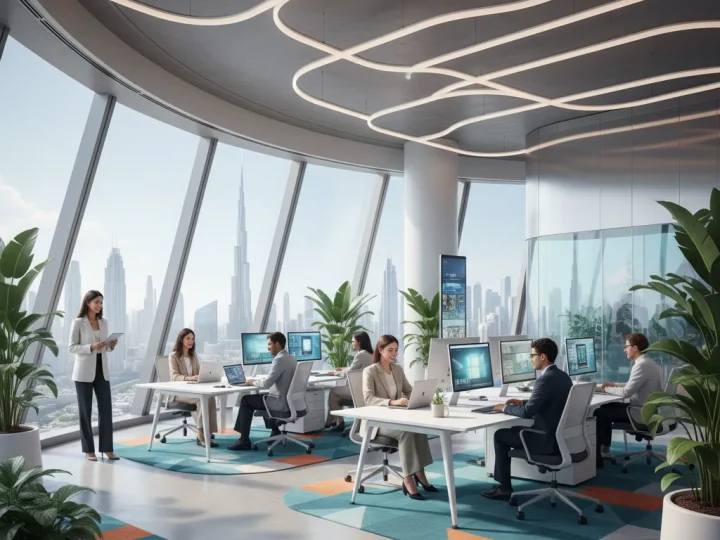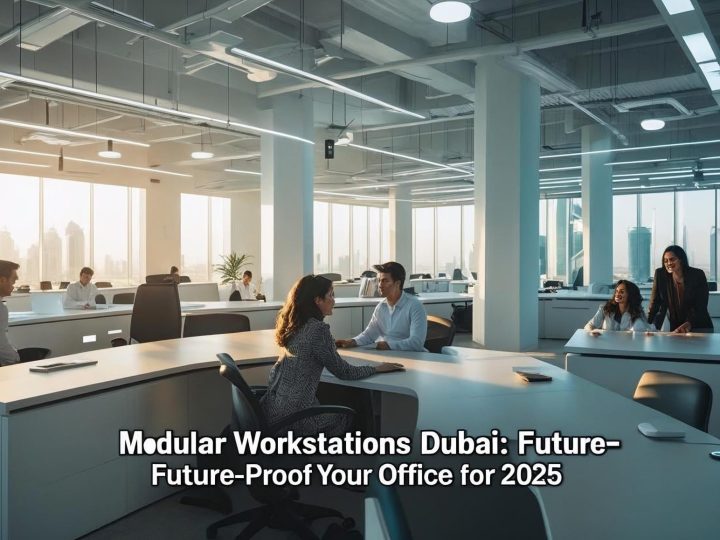
Choosing a conference room table might sound simple, but the reality is very different. Offices lose surprising amounts of productivity just from cramped spaces and the wrong table shapes. In fact, experts recommend allocating up to 35 square feet per person depending on your table layout. Most people focus on price tags or trendy looks, but the strongest decision-makers know the real secret to a productive meeting is matching the table to your space, your team, and even your tech needs.
Table of Contents
- Understand Your Space Requirements
- Consider Table Shape And Size
- Think About Mobility And Flexibility
- Choose The Right Material For Durability
- Incorporate Technology Needs
- Prioritize Comfort And Ergonomics
- Define Your Budget For Conference Tables
Quick Summary
| Takeaway | Explanation |
|---|---|
| Understand your space needs first | Measure total square footage to ensure adequate room for collaboration during meetings. |
| Choose table shape for productivity | Select shapes like rectangular for structure, or round for equal participation based on your meeting style. |
| Prioritize mobility and flexibility | Opt for lightweight, modular tables to adapt to various meeting styles and facilitate quick reconfiguration. |
| Select durable materials for longevity | Choose materials resistant to wear and easy to maintain to ensure your investment lasts through heavy use. |
| Budget for long-term value, not just price | Consider total costs, including maintenance and functionality, to make informed investment decisions for your meeting space. |
1: Understand Your Space Requirements
Choosing the right office conference room tables begins with a critical first step: thoroughly understanding your workspace dimensions and layout. Space requirements are the foundation of creating an effective meeting environment that promotes collaboration and productivity.
Careful measurement is essential. Before selecting any conference room tables, you need to accurately assess the total available square footage and consider multiple functional aspects. According to Arizona State University’s event planning guidelines, different table configurations require varying space allocations:
- Hollow square setup: Approximately 30 square feet per person
- U-shape configuration: Around 35 square feet per person
These measurements ensure participants have sufficient room for movement, equipment placement, and comfortable interaction. Cramped spaces can inhibit communication and create an unproductive atmosphere.
Key considerations for space planning include:
- Total number of potential meeting participants
- Required technological infrastructure (projectors, screens, power outlets)
- Potential future growth or reconfiguration needs
To maximize your conference room’s potential, consider our comprehensive guide on selecting conference room furniture which provides deeper insights into creating optimal meeting spaces.
Remember that table size and shape must harmonize with your room’s architectural constraints. An oversized table can make a room feel restrictive, while an undersized table might appear inadequate. Precision in measurement and strategic selection are your pathways to creating an inviting, functional conference environment.
2: Consider Table Shape and Size
Selecting the optimal conference room table involves more than aesthetic preferences. Shape and size are critical factors that directly impact collaboration, communication, and overall meeting productivity. According to CDC ergonomic guidelines, table design plays a significant role in workplace interaction and employee comfort.
Table shapes dramatically influence meeting dynamics. Rectangular tables traditionally dominate corporate conference rooms, offering structured seating arrangements and clear hierarchical positioning. However, alternative shapes can transform interaction patterns:
- Rectangular tables: Best for formal presentations and linear communication
- Round tables: Encourage equal participation and informal discussions
- Modular tables: Provide flexibility for reconfiguring space as needed
Size selection requires careful consideration of your specific workspace and team requirements. Standard conference tables typically range from 6 to 24 feet in length, accommodating groups from 4 to 20 participants. Smaller organizations might prefer compact 6 to 8 foot tables, while larger corporations often require expansive 20 to 24 foot configurations.
Ergonomic factors are equally important. Adequate legroom, appropriate height, and sufficient surface area contribute to participant comfort. A well-designed conference table should allow approximately 24 to 30 inches of width per person, ensuring sufficient workspace for laptops, documents, and collaboration tools.
Explore our comprehensive guide on selecting conference room furniture for more detailed insights into creating the perfect meeting environment. Your table choice is more than furniture selection it is an investment in your team’s communication and productivity.
3: Think About Mobility and Flexibility
Modern conference rooms demand adaptable furniture solutions that can transform with changing business needs. According to Whole Building Design Guide, workplace design must prioritize systems that are controllable and easily adjustable.
Mobility in conference room tables represents more than just physical movement it signifies organizational agility. Contemporary businesses require furniture that can quickly reconfigure to support various meeting styles, team sizes, and collaborative formats.
Key mobility considerations include:
- Lightweight, wheeled table designs
- Modular tables that can be easily combined or separated
- Quick-release locking mechanisms for rapid setup
Technology integration plays a crucial role in creating flexible conference spaces. Wireless connectivity and integrated power solutions enable seamless transitions between different meeting configurations. Tables with built-in charging stations, cable management systems, and adaptable technological interfaces support dynamic work environments.
Ergonomic flexibility is equally important. Height-adjustable tables allow teams to switch between seated and standing positions, promoting better health and engagement during meetings. This adaptability supports diverse working styles and physical comfort needs.
Explore our latest modular office furniture solutions to discover how innovative design can transform your conference room. The right furniture does more than occupy space it creates opportunities for collaboration, creativity, and organizational growth.
4: Choose the Right Material for Durability
Selecting the right material for conference room tables is crucial for long-term performance and aesthetic appeal. According to US Nuclear Regulatory Commission guidelines, material selection directly impacts furniture longevity and resistance to workplace wear.
Conference room tables endure significant daily stress, from heavy equipment placement to frequent meetings and technological interactions. The material you choose must withstand these challenges while maintaining professional appearance and functionality.
Key material considerations include:
- Resistance to scratches and impact damage
- Ease of cleaning and maintenance
- Ability to integrate technology seamlessly
Wood remains a popular choice, offering classic aesthetics and natural warmth. Hardwoods like maple, oak, and walnut provide exceptional durability and can withstand years of professional use. Laminate options offer cost-effective alternatives with improved scratch and stain resistance.
Metallic materials such as steel and aluminum bring modern durability to conference room environments. These materials provide exceptional structural integrity and support heavy technological infrastructure. Stainless steel and powder-coated metals resist corrosion and maintain their professional appearance through extensive use.
Learn more about our innovative office furniture materials to understand how advanced materials can transform your conference room. Your table is more than furniture it is an investment in your organization’s professional image and functional efficiency.
5: Incorporate Technology Needs
Modern conference rooms are technological ecosystems that demand intelligent furniture design. According to University of Wisconsin–Madison’s technology integration guidelines, conference tables must seamlessly support diverse digital collaboration platforms.
Technology integration is no longer optional it is essential. Conference room tables now function as sophisticated technological interfaces, supporting multiple devices, connectivity requirements, and collaborative workflows.
Critical technology considerations include:
- Integrated power outlets and USB charging ports
- Cable management systems
- Wireless connectivity support
Strategic table design can transform technological interactions. Built-in cable management systems prevent tangled wires, while recessed power modules enable clean, professional connections. Hidden compartments for laptops, tablets, and presentation equipment maintain a streamlined aesthetic while providing maximum functionality.
Ergonomic technology integration goes beyond mere connectivity. Tables with adjustable screen mounts, pop-up monitor systems, and touch-panel controls create seamless meeting experiences. These features support hybrid work environments, allowing smooth transitions between in-person and remote participation.
Explore our latest office furniture innovations to understand how intelligent design can revolutionize your conference room. The right table does more than host meetings it becomes a powerful technological collaboration platform.
6: Prioritize Comfort and Ergonomics
Ergonomics transform conference room tables from mere furniture to strategic workplace wellness solutions. According to E3S Web of Conferences research, thoughtful design directly impacts participant comfort and productivity.
Workplace comfort is not a luxury it is a fundamental requirement for effective collaboration. Conference room tables must support diverse body types, working styles, and extended meeting durations while minimizing physical strain.
Key ergonomic considerations include:
- Adjustable height mechanisms
- Adequate leg room and space between participants
- Smooth surface edges to prevent wrist strain
Surface height and depth play critical roles in participant comfort. Tables should accommodate various seating positions, allowing users to maintain proper posture during lengthy meetings. Ideal table heights typically range between 28 to 30 inches, with variations possible through adjustable mechanisms.
Material selection also impacts ergonomic performance. Smooth, non-reflective surfaces reduce eye strain, while rounded edges prevent accidental bumps and discomfort. Lightweight materials with integrated cable management systems further enhance user experience by reducing physical obstacles.
Discover our comprehensive guide to workspace ergonomics to understand how intelligent design can transform meeting experiences. Your conference room table is more than furniture it is a critical tool for employee wellness and organizational productivity.
7: Define Your Budget for Conference Tables
Budgeting for conference room tables requires strategic financial planning beyond simple price comparison. According to University of California procurement guidelines, smart purchasing involves understanding total value and long-term investment potential.
Conference tables are not expenses they are investments in workplace productivity. Budget considerations extend far beyond initial purchase price, encompassing durability, functionality, and potential impact on team collaboration.
Key budgeting factors include:
- Initial purchase cost
- Long-term maintenance expenses
- Potential productivity gains
Price ranges for conference tables vary dramatically, typically spanning from $500 for basic models to $5,000 for high-end, technologically integrated solutions. Small businesses might invest $1,500 to $2,500 for a quality table, while larger corporations could allocate $3,000 to $7,000 for premium configurations.
Consider total cost of ownership beyond the sticker price. A more expensive table with superior durability and technological integration might provide better long-term value. Factors like built-in power outlets, cable management systems, and ergonomic design can justify higher initial investments by enhancing workplace efficiency.
Learn more about selecting the perfect conference room furniture to make an informed decision. Remember, your conference table is a strategic asset that reflects your organization’s professionalism and commitment to employee experience.
The table below offers a comprehensive summary of the 7 essential tips for choosing office conference room tables, highlighting the main focus, key actions, and unique benefits described in the article.
| Tip | Key Actions/Considerations | Benefits/Outcomes |
|---|---|---|
| Understand Space Requirements | Measure room dimensions, consider participant count, plan for future growth and tech needs | Ensures an adequate, comfortable, and productive meeting environment |
| Consider Table Shape & Size | Choose table shape (rectangular, round, modular) and size based on meeting style and room layout | Enhances collaboration, meeting flow, and ergonomic comfort |
| Prioritize Mobility & Flexibility | Opt for lightweight, modular, wheeled, or adjustable-height tables | Provides adaptability for diverse meetings and maximizes usability |
| Select Durable Materials | Choose woods, laminates, metals that resist wear and suit tech needs | Prolongs lifespan and maintains professional appearance |
| Incorporate Technology Needs | Integrate power outlets, cable management, USB, wireless, and smart tech features | Supports seamless digital collaboration and future growth |
| Prioritize Comfort & Ergonomics | Ensure adjustable height, legroom, smooth edges, and user-friendly surfaces | Boosts wellness and meeting productivity for all participants |
| Define Your Budget | Factor in total cost, maintenance, long-term value, and tech/ergonomic features | Maximizes investment while aligning with productivity goals |
Transform Your Conference Room With Custom Furniture Solutions
Are you struggling to find a conference table that truly fits your space or supports your team’s technology needs? Many businesses face challenges when it comes to optimizing office layouts, selecting durable materials, and integrating modern features. As discussed in the article, the right table is much more than just a piece of furniture. It directly impacts collaboration, comfort, and productivity. When your existing options feel cramped, outdated, or inflexible, it is time to explore a smarter approach.

Discover how SAGTCO can help you achieve a workspace that reflects your vision. Our expert team offers free space planning and personalized guidance, drawing from our comprehensive office furniture catalog and innovative solutions featured in the latest workspace trends. Act now and connect with us to receive a tailored solution that will turn your next meeting into a success. Do not let your workplace fall behind. Contact us today through SAGTCO’s official site and take the first step toward a more productive and impressive conference room.
Frequently Asked Questions
What factors should I consider when measuring space for conference room tables?
You should consider the total available square footage, the number of participants, and the layout for various table configurations to ensure comfortable movement and interaction during meetings.
How does the shape of a conference table impact meeting dynamics?
The shape influences communication styles; for example, rectangular tables are suited for formal presentations, while round tables promote equal participation and informal discussions.
What materials are ideal for durable conference room tables?
Wood, metal, and laminate are popular choices. Hardwoods like maple and oak offer durability, while metal provides structural integrity. Laminate options can offer cost-effective scratch resistance.
Why is ergonomic design important for conference room tables?
Ergonomic design supports participant comfort and reduces physical strain during meetings, enhancing productivity. Factors like adjustable height, adequate legroom, and smooth surface edges are key considerations.
Recommended
- 2025 Guide: How to Select Conference Room Furniture – Office Furniture Dubai | Buy Modern Office Furniture Dubai – SAGTCO
- Here’s The 6 Things Needed To Create An Awesome Conference Room in Dubai Abu Dhabi – Office Furniture Dubai | Buy Modern Office Furniture Dubai – SAGTCO
- Furniture Types for Different Office Spaces 2025 – Office Furniture Dubai | Buy Modern Office Furniture Dubai – SAGTCO
- The Top 10 Conference Tables of 2016 – Office Furniture Dubai | Buy Modern Office Furniture Dubai – SAGTCO




